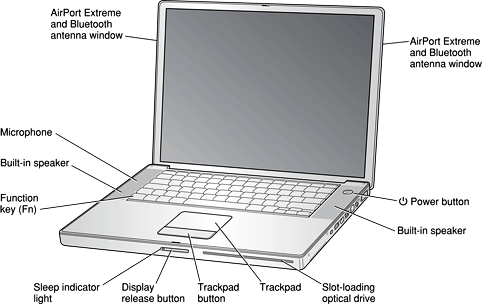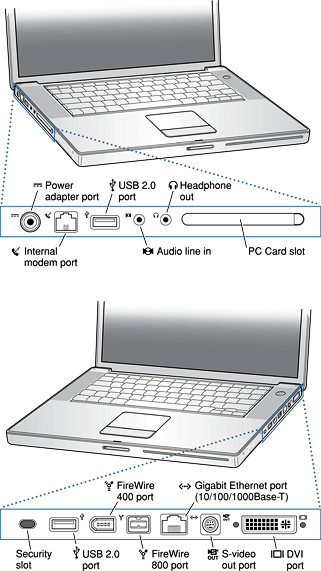Overview of the 15-inch PowerBook G4
This chapter outlines the features of the 15-inch PowerBook G4, with emphasis on the changes from the previous models.
In this section:
New Features
All Features
Appearance
Peripheral Devices
System Software
New Features
The features that have changed are listed here along with references to the sections that describe them. For a quick summary of the feature comparison of these models to the previous release models, see Table 1-1.
Processor: The computer has a PowerPC G4 microprocessor running at a clock speed of 1.33 GHz or 1.5 GHz. For more information, see “PowerPC G4 Microprocessor.”
RAM: The computer has two SO-DIMM expansion slots for DDR SDRAM modules. The computer comes with 256 MB or 512 MB of DDR SDRAM. RAM is expandable up to 2 GB. See “RAM Expansion Slots.”
Hard disk storage: The computer comes with a built-in 4200 rpm hard disk drive with a capacity of 60 or 80 GB. An 80 GB 5400 rpm disk drive is available as a build-to-order option. For more information, see “Hard Disk Drive.”
Graphics IC and memory: The ATI Mobility Radeon 9700 graphics controller operates on the AGP4x bus with 64 MB of video RAM. Available on the 1.5 GHz configuration is 128 MB of video RAM. For more information, see “Video Display Subsystem.”
AirPort Extreme: The 54 Mbps AirPort Extreme is standard in both models. See “AirPort Extreme.”
Weight: The basic configuration weighs 2.6 kg (5.7 pounds).
All Features
Here is a list of the features of the 15-inch PowerBook G4. Each feature is described in a later chapter, as indicated in the list.
Processor: The computer has a PowerPC G4 microprocessor running at a clock speed of 1.33 GHz or 1.5 GHz. For more information, see “PowerPC G4 Microprocessor.”
Enclosure: The 15-inch PowerBook G4 has a lightweight aluminum alloy enclosure.
System bus: The speed of the system bus is 167 MHz in both models.
Cache: Internal to the processor IC is a 512 KB L2 cache. See “Level 2 Cache.”
RAM: The computer has two SO-DIMM expansion slots for DDR SDRAM modules. The computer comes with 256 MB or 512 MB of DDR SDRAM. RAM is expandable up to 2 GB. See “RAM Expansion Slots.”
ROM: The computer has 1 MB of boot ROM used by Open Firmware at startup. For information about the ROM, see “Boot ROM.” For information about Open Firmware, see “Open Firmware.”
Hard disk storage: The computer comes with a built-in 4200 rpm hard disk drive with a capacity of 60 or 80 GB. An 80 GB 5400 rpm disk drive is available as a build-to-order option. For more information, see “Hard Disk Drive.”
Display: The display is a 15.2 inch wide-screen TFT (1280 by 854 pixels) with a resolution of 101.4 dpi. See “Flat-Panel Display.”
External monitor: All configurations support an external video monitor, using the DVI-I connector for a digital video display and an S-video connector for a PAL or NTSC video monitor. (A VGA adapter and an S-video-to-composite adapter are included and an ADC adapter is available separately.) See “External Monitors.”
Graphics IC and memory: The ATI Mobility Radeon 9700 graphics controller operates on the AGP4x bus with 64 MB of video RAM. Available on the 1.5 GHz configuration is 128 MB of video RAM. For more information, see “Video Display Subsystem.”
Battery: The computer has a single battery pack that uses lithium ion cells and provides 50 watt-hours at 12.8 V (nominal).
Power adapter: The computer comes with a 65 W power adapter with grounded plug.
Optical drive: Some configurations have a built-in Combo drive and some configurations have a built-in SuperDrive. See “Combo Drive” or “SuperDrive.”
CardBus slot: The computer has a CardBus slot that accepts one Type I or Type II PC card or a CardBus Card. For more information, see “PC Card/CardBus Slot.”
USB 2.0 ports: The computer has two USB 2.0 ports for an external keyboard, a mouse, and other USB devices, described in “USB 2.0 Ports.”
FireWire ports: The computer has one IEEE-1394a FireWire 400 port and one IEEE-1394b FireWire 800 port. For more information, see “FireWire Ports.”
Target disk mode: The 15-inch PowerBook G4 can act like a FireWire storage device connected to another computer. See “Target Disk Mode”
Modem: The computer has a built-in modem with 56 Kbps data rate and V.92 support. For more information, see “Internal Modem.”
Ethernet: The computer has a built in Ethernet port with an RJ-45 connector for 10Base-T, 100Base-T, and 1000Base-T operation. For more information, see “Ethernet Port.”
AirPort Extreme: The 54 Mbps AirPort Extreme is standard in both models. See “AirPort Extreme.”
Bluetooth support: Fully-integrated Bluetooth support enables short-range wireless connections between desktop and laptop computers and a host of other peripheral devices. For more information, see “Bluetooth Technology.”
Sound: The computer has a built-in microphone, stereo speakers with mid-range enhancing third speaker, an audio line in, and headphone out. See “Sound System.”
Keyboard: The keyboard has an embedded numeric keypad and inverted-T arrow keys. Some of the function keys are used to control the display brightness and speaker volume. See “Keyboard.”
Illuminated keyboard: Some configurations of the 15-inch PowerBook G4 have a backlit keyboard for optimal visibility in all lighting conditions. For more information, see “Keyboard.”
Ambient light sensor: The computer configurations that have a backlit keyboard also have an ambient light sensor which monitors light levels and activates the illuminated backlit keyboard and adjusts the display brightness.
Trackpad: The integrated trackpad includes tap/double-tap and drag features. For more information, see “Trackpad.”
Weight: The basic configuration weighs 2.6 kg (5.7 pounds).
Size: The15-inch PowerBook G4 is 348 mm (13.7 inches) wide, 241 mm (9.5 inches) deep, and 28 mm (1.1 inches) thick.
Appearance
Figure 1-1 is a front view of the 15-inch PowerBook G4 computer. Figure 1-2 provides side views that show the I/O ports.
Peripheral Devices
In addition to the devices that are included with the computer, several peripheral devices are available separately:
The 15-inch PowerBook G4 Rechargeable Battery is available separately as an additional or replacement battery.
The Apple Portable Power Adapter, which comes with the computer, is also available separately. The adapter can fully recharge a completely depleted battery in 2 to 2.5 hours when the computer is shut down and in a little over three hours when the computer is in sleep mode.
Note: The 15-inch PowerBook G4 is designed to use the 65 W Apple Portable Power Adapter which ships with it (the adapter is labeled with a “65W” icon on the lower front). A 45 W Apple portable power adapter works with the 15-inch PowerBook G4, but may provide insufficient power during some activities and power may be drawn temporarily from the battery. Therefore a 45 W power adapter is not recommended.
The Apple DVI to ADC Adapter, which enables the 15-inch PowerBook G4 to support Apple’s ADC displays, is available separately.
The Apple Keyboard, a full-featured, wired USB keyboard, is available separately.
The Apple Mouse, an optical, wired USB mouse, is available separately.
The Apple Wireless Mouse with built-in Bluetooth is available separately.
The Apple Wireless Keyboard with built-in Bluetooth is available separately.
The AirPort Extreme Base Station is available separately.
System Software
The 15-inch PowerBook G4 comes with Mac OS X version 10.3.3 installed and runs Mac OS 9 applications in Classic mode. For the latest information, see the references listed in “Mac OS X.”
Here are a few items of interest about the system software on the 15-inch PowerBook G4.
Open Firmware
System software on all current Macintosh models uses a design based on Open Firmware. With this approach, the ROM on the main logic board contains only the Open Firmware code needed to initialize the hardware and load an operating system. The rest of the system code is loaded into RAM from disk or from the network. For more information, see the references listed in “Open Firmware.”
Computer Identification
Rather than reading the box flag or the model string and then making assumptions about the computer’s features, applications that need to find out the features of the computer should use IORegistry calls to test for the features they require. IORegistry calls are part of the I/O Kit API. For more information, see the references listed at “I/O Kit.”
Asset management software that reports the kind of computer it is running on can obtain the value of the model property from the IOService plane of the IORegistry. For the 15-inch PowerBook G4, the value of the model property is PowerBook5,4.
Power Management
Apple’s power management techniques for the 15-inch PowerBook G4 are described in the following paragraphs.
Power Saving States
The power management protocols on the 15-inch PowerBook G4 support two power-saving states: idle and sleep.
Idle: The system is idling with the main processor in a low-power state. All clocks are running; the system can return to running code within a few nanoseconds. Cache coherency is maintained in this state. The CPU automatically transitions between run and idle, independent of the operating frequency. The operating frequency is based on the processor power management setting. For additional information, see “Processor Power Management.”
Sleep: Most internal components are powered off and the state is saved; the DRAM state is preserved for quick recovery. All processors are powered off with their state preserved in DRAM. All clocks in the system are suspended except for the 32.768 kHz timebase crystal on the PMU99 IC.
The computer automatically enters idle state after a few hundred miliseconds of inactivity. If the computer is attached to a network, it is able to respond to service requests and other events directed to the computer while it is in idle state.
While it is connected to an AC power supply, the computer can also respond to network activity when it is in sleep state. The user can enable this feature by selecting Wake-on-LAN in the Energy Saver preference pane.
When operating on the battery in sleep state, the computer consumes less than 1 watt of power, meeting the Energy Star power-saving standard. When operating on the power adapter in sleep state, the combined computer and adapter consume 3 to 4 watts of power.
Important: Peripherals such as PCMCIA cards and USB devices that do not conform to the computer’s power management protocols prevent the computer from switching to sleep state and so deny the user the benefits of this energy-saving state.
Processor Power Management
To lower power consumption and heat generation, the 15-inch PowerBook G4 incorporates an automatic power management technique called dynamic frequency switching (DFS). DFS is designed to run at high processor speed and voltage when the demand on the processor is high, and to run at low processor speed and voltage when the demand on the processor is low. When DFS is enabled, the processor dynamically adjusts its speed based on the current needs of the system. Depending on the configuration, the processor speed will switch between 1333 MHz and 667 MHz or 1500 MHz and 750 MHz.
Switching between different processor speeds and voltages is achieved by a transition that operates seamlessly to the user and should not impact system or application performance.
The 15-inch PowerBook G4 allows the user to control DFS mode. The options for specifying either high, reduced, or automatic processor and bus speeds are located at System Preferences>Energy Saver>Show Details>Options>Processor Performance; then select Highest, Automatic, or Reduced. DFS is enabled with the automatic setting, for processor performance.
If the 15-inch PowerBook G4 detects a system temperature that is high, due to high ambient temperatures or other factors, it will automatically force the system to reduce the speed regardless of the selected setting.
Note: The 15-inch PowerBook G4 meets all applicable safety standards, including UL 60950 and IEC 60950.
© 2003, 2004 Apple Computer, Inc. All Rights Reserved. (Last updated: 2004-04-19)

